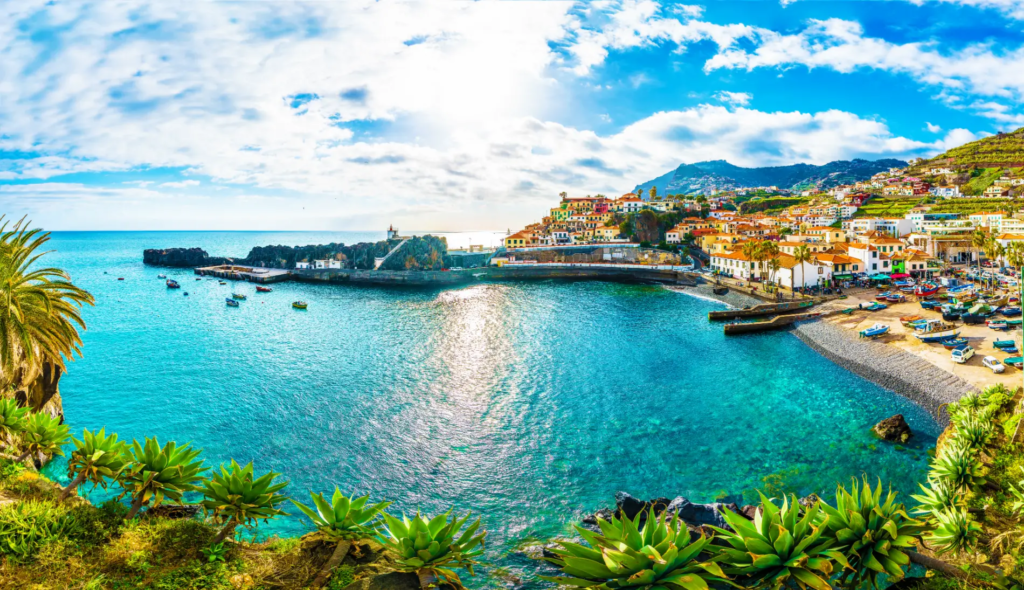“Uncovering Portugal’s Hidden Gems: Uncovering Travel and Tourism Secrets”

In the article “Unveiling Portugal’s Hidden Gems: The Secrets of Travel and Tourism Revealed,” you can explore several unique aspects of Portugal’s travel and tourism industry. Here are a few ideas:
- Offbeat Destinations: Highlight lesser-known and off-the-beaten-path destinations in Portugal that offer unique experiences, such as charming villages, secluded beaches, or hidden natural wonders. Discuss how these hidden gems provide an authentic and less crowded travel experience.
- Culinary Delights: Explore Portugal’s diverse and delicious gastronomy, including iconic dishes like bacalhau (salted cod), pastéis de nata (custard tarts), and regional specialties. Dive into the country’s wine regions, such as the Douro Valley or Alentejo, and showcase the unique flavors and traditions associated with Portuguese cuisine.
- Rich Cultural Heritage: Discuss Portugal’s fascinating history and its impact on the country’s cultural heritage. Highlight historic landmarks, UNESCO World Heritage Sites, and architectural marvels like the Belém Tower, Jerónimos Monastery, or Pena Palace. Explore the influence of Portuguese explorers on the global stage.
- Festivals and Traditions: Shed light on Portugal’s vibrant festival culture, such as the lively street parties during Lisbon’s Santo António celebrations or the religious processions of Semana Santa in Braga. Discuss regional festivals, traditional music like fado, and vibrant local customs that add color and liveliness to the country’s cultural tapestry.
- Outdoor Adventures: Showcasing Portugal’s natural beauty, discuss outdoor activities like hiking in the Peneda-Gerês National Park, surfing in the waves of Nazaré, or exploring the stunning coastline of the Algarve. Highlight the country’s diverse landscapes, from rugged mountains to picturesque vineyards and breathtaking coastal cliffs.
- Sustainable Tourism: Discuss Portugal’s commitment to sustainable and responsible tourism practices. Highlight initiatives promoting eco-tourism, conservation projects, and eco-friendly accommodations. Showcase how Portugal is striving to preserve its natural and cultural heritage for future generations.
- Warm Hospitality: Emphasize the welcoming and friendly nature of the Portuguese people. Discuss the warmth of local communities, the tradition of hospitality, and personal anecdotes that showcase the unique experiences and connections travelers can make while visiting Portugal.
By delving into these unique aspects of Portugal’s travel and tourism industry, the article will provide readers with a deeper understanding of the country’s hidden gems, cultural richness, and the unforgettable experiences they can have while exploring this captivating destination.

Portugal has been actively promoting eco-tourism and implementing conservation projects to protect its natural heritage. Here are some notable initiatives:
- Rota Vicentina: Rota Vicentina is a network of walking trails along the southwest coast of Portugal, covering over 400 kilometers. It offers stunning coastal scenery, diverse ecosystems, and the opportunity to explore local culture and traditions. The project focuses on sustainable tourism, preserving the region’s biodiversity, and promoting responsible travel practices.
- Parque Nacional da Peneda-Gerês: Located in northern Portugal, Peneda-Gerês National Park is the country’s only national park. It is known for its rugged mountains, pristine rivers, and rich biodiversity. The park engages in various conservation efforts, including habitat restoration, wildlife protection, and sustainable tourism development.
- Ria Formosa Natural Park: Situated along the Algarve coast, Ria Formosa is a protected area known for its unique wetlands, lagoons, and diverse birdlife. The park implements conservation programs, educational initiatives, and sustainable tourism practices to preserve its delicate ecosystems and promote environmental awareness.
- Berlengas Archipelago: The Berlengas Archipelago, located off the coast of Peniche, is a protected nature reserve and UNESCO Biosphere Reserve. It is home to rare seabird species, including the iconic puffins. Conservation efforts focus on protecting the archipelago’s biodiversity, controlling human impact, and promoting sustainable tourism activities.
- Cork Oak Forests: Portugal is known for its extensive cork oak forests, particularly in the Alentejo region. These forests play a crucial role in biodiversity conservation and carbon sequestration. Sustainable cork harvesting practices are employed, ensuring the long-term health of the forests and supporting local communities.
- Dolphin Watching and Marine Conservation: Along the Portuguese coast, particularly in the Azores and Madeira, there are opportunities for dolphin and whale watching. Many operators adhere to responsible guidelines to minimize disturbance to marine life. Additionally, local organizations and research institutions are actively involved in marine conservation projects, focusing on the protection and preservation of cetaceans and their habitats.
- Dark Sky Reserves: Portugal is home to two Dark Sky Reserves, Alqueva and Montesinho, which are dedicated to preserving the quality of the night sky and promoting astronomy tourism. These reserves implement outdoor lighting regulations to reduce light pollution and raise awareness about the importance of stargazing and the preservation of the night sky.
These eco-tourism initiatives and conservation projects in Portugal showcase the country’s commitment to preserving its natural wonders, promoting sustainable practices, and providing unique and responsible travel experiences for visitors. They offer opportunities to engage with nature, contribute to conservation efforts, and gain a deeper appreciation for Portugal’s environmental heritage.

there are generally guidelines and regulations in place for visitors to eco-tourism sites in Portugal. While these guidelines can vary depending on the specific site and its management, here are some common practices and regulations:
- Stay on designated trails: Visitors are often required to stay on designated trails to minimize disturbance to sensitive ecosystems and prevent damage to flora and fauna. This helps protect the natural habitat and ensures that visitors can enjoy the sites without causing harm.
- Respect wildlife: It is important to observe wildlife from a respectful distance and refrain from feeding or touching animals. This helps maintain their natural behavior and prevents potential harm to both the animals and visitors.
- Leave no trace: Visitors are encouraged to follow the “leave no trace” principles, which include packing out all trash, avoiding littering, and leaving the environment as you found it. This helps preserve the pristine condition of the eco-tourism sites and minimizes the impact on the surrounding ecosystems.
- Follow specific site rules: Each eco-tourism site may have specific rules and regulations depending on its unique characteristics and conservation needs. These could include restrictions on camping, fishing, or the use of certain equipment. It is important to familiarize yourself with any site-specific guidelines before visiting.
- Support local communities and businesses: Eco-tourism often aims to benefit local communities and promote sustainable economic development. Consider supporting local businesses, purchasing local products, and participating in community-led initiatives to contribute positively to the local economy and foster sustainable practices.
- Educate yourself: Take the time to learn about the eco-tourism site you plan to visit, including its conservation goals, cultural significance, and any ongoing research or preservation efforts. This knowledge will enhance your experience and enable you to appreciate the site’s value and importance.
It’s worth noting that these guidelines are not exhaustive and may vary depending on the specific eco-tourism site. Visitors are encouraged to check with the site’s management or local authorities for any specific regulations or guidelines that may be in place to ensure a responsible and enjoyable visit.

Here are a few examples of eco-tourism sites in Portugal that have their own specific regulations and guidelines for visitors:
- Parque Nacional da Peneda-Gerês: Portugal’s only national park, Peneda-Gerês, has specific regulations to protect its natural and cultural heritage. Visitors are required to follow marked trails, and off-trail hiking is usually restricted to prevent damage to sensitive ecosystems. Camping is allowed only in designated areas, and open fires may be prohibited during certain periods to prevent forest fires. Fishing and hunting are regulated, and permits may be required.
- Ria Formosa Natural Park: Ria Formosa, a coastal wetland park in the Algarve, has regulations to protect its fragile ecosystems. Visitors are encouraged to stay on marked trails and boardwalks to avoid disturbing wildlife and sensitive habitats. Some areas may be off-limits during nesting seasons to protect nesting birds. Water activities, such as boating and kayaking, may have restrictions to prevent disturbance to seagrass beds and wildlife.
- Berlengas Archipelago: The Berlengas Archipelago, a protected nature reserve, has specific regulations to ensure the conservation of its unique ecosystems. Visitors are required to stay on designated paths and are prohibited from picking flowers or disturbing wildlife. Camping is not allowed on the islands, and access to certain areas may be restricted during specific periods to protect nesting seabirds.
- Dark Sky Reserves (Alqueva and Montesinho): The Dark Sky Reserves in Alqueva and Montesinho have specific regulations to preserve the quality of the night sky and minimize light pollution. Outdoor lighting regulations are in place to control light emissions and ensure that artificial lighting does not interfere with astronomical observations. Visitors are encouraged to use red-filtered lights and adhere to specific guidelines to preserve the darkness of the night sky.
These are just a few examples, and other eco-tourism sites in Portugal may have their own specific regulations and guidelines. It’s essential for visitors to familiarize themselves with the rules and guidelines of each site they plan to visit to ensure a responsible and environmentally conscious experience.

While specific regulations can vary from site to site, there are some common regulations for eco-tourism sites in Portugal. Here are a few examples:
- Stay on designated paths and trails: This is a common regulation to minimize damage to vegetation and prevent disturbance to wildlife. Visitors are often required to stick to marked paths and trails to avoid trampling on sensitive habitats and ecosystems.
- Respect wildlife and do not feed animals: Visitors are typically instructed to observe wildlife from a distance and avoid feeding them. Feeding wildlife can disrupt their natural behaviors, alter their diet, and even cause dependency on human food sources, which can be harmful to their health.
- Practice “leave no trace”: The “leave no trace” principle is commonly encouraged in eco-tourism sites. Visitors are expected to clean up after themselves, pack out all trash, and leave the environment as they found it. This includes properly disposing of waste, avoiding littering, and minimizing their impact on the surroundings.
- Follow specific site rules and restrictions: Each eco-tourism site may have its own set of rules and restrictions based on its unique characteristics and conservation needs. These rules can relate to activities such as camping, fishing, picnicking, or the use of certain equipment. Visitors are expected to adhere to these rules to protect the environment and maintain the site’s integrity.
- Respect cultural and historical sites: Many eco-tourism sites in Portugal have cultural or historical significance. Visitors are typically required to respect and preserve these sites by not damaging or removing artifacts, refraining from graffiti or vandalism, and following any additional guidelines provided by the site management.
- Minimize noise and disturbance: Maintaining a peaceful and natural environment is crucial in eco-tourism sites. Visitors are often asked to minimize noise levels, avoid playing loud music, and respect the tranquility of the surroundings. This helps preserve the natural ambiance and allows wildlife to thrive undisturbed.
It’s important to note that while these are common regulations, they can vary depending on the specific site and its management. Visitors should always check for any site-specific regulations and guidelines before their visit to ensure they are contributing to the preservation and sustainability of the eco-tourism site they are exploring.
As soon as you click on the links below , we register for you free purchase discount codes , we wish you a statement , We are pleased with your comments
https://compensair.tp.st/oNAhOZVk



